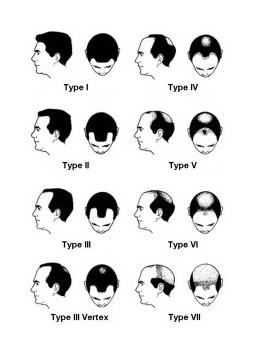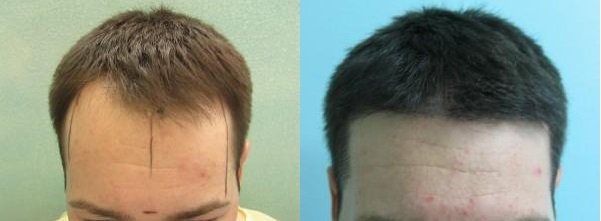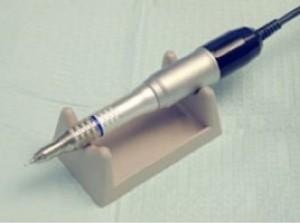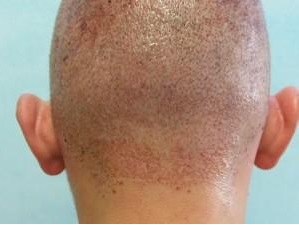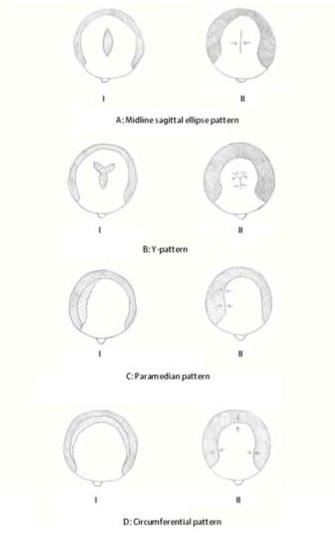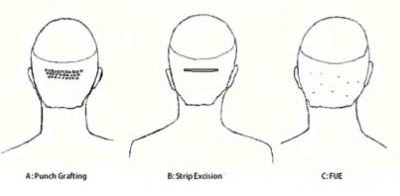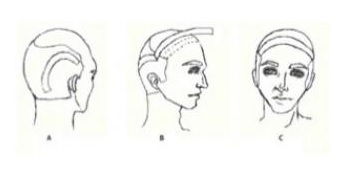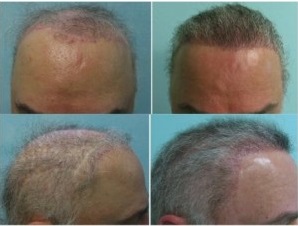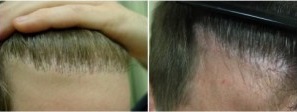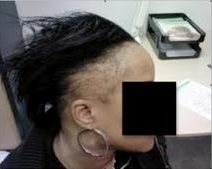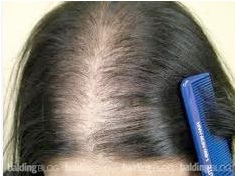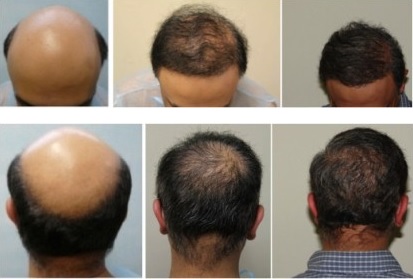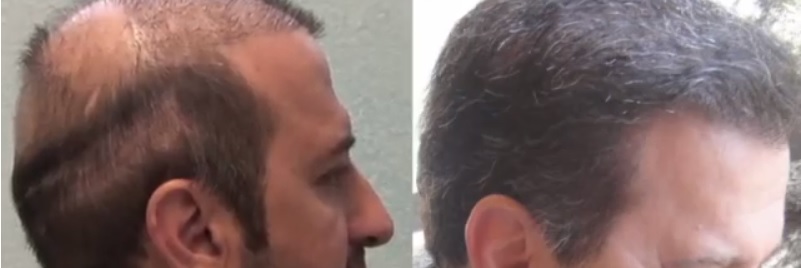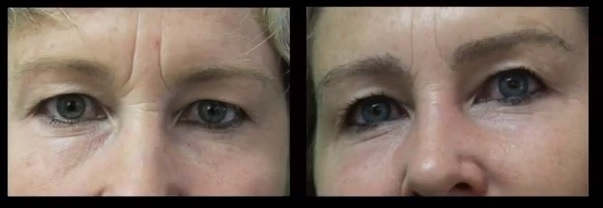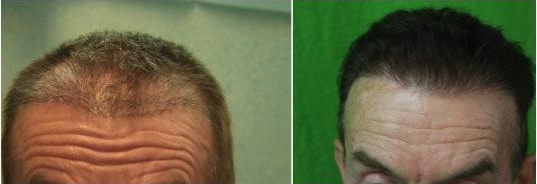Hair loss undoubtedly causes individuals to feel distraught and less confident about their appearance. This can lead to mental and emotional imbalances as well as impacting social relationships.
Although thinning and balding is largely associated with men, it is also prevalent in women as well. Choosing the right treatment will require the consideration of causal factors as well as safety.
Background on Hair Loss Conditions and Causes
According to the AHI (American Health Institute), 40 million men and 21 million women suffer from higher than average rates of thinning and balding. Over 90% of these cases can be attributed to androgenic alopecia
What Is Androgenic Alopecia
Many individuals inherit genes on the X-chromosome which lead to their hair loss condition. However, these can be passed down either from the mother or father’s side of the family. Scientists are starting to learn that a combination of different genes contributes to androgenic alopecia (common genetic baldness, also known as pattern baldness).
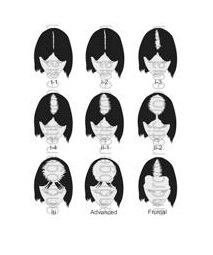
The Savin scale shows that women tend to show different patterns of hair loss and thinning compared to men
The DNA that causes pattern baldness carries deviations in the sequencing of its code. Instead of serving as the blueprint for normal androgen protein receptors embedded in the hair follicle, these genes will create structures that are highly sensitive to the effects of a testosterone breakdown product known as DHT (dehydrotestosterone).
Once DHT binds to these affected receptors, it will interfere with the normal absorption of nutrients and building blocks from the blood stream. This basically starves the follicle and leads to its gradual shrinkage. Eventually, the structure will lose its capability to produce new hair.
Within the male population, statistics show that two thirds of men will experience the signs of pattern baldness by age 35. And 85% will see the manifestations of hair loss by age 50.
Modern hair transplant procedures can reliably reverse the signs of hair loss and thinning in individuals who have enough donor grafts to achieve desired levels of coverage. For the most part, these surgeries are performed on candidates suffering from androgenic alopecia
Environmental Contributors to Pattern Baldness
While genetics affects most of these individuals and is responsible for their pattern baldness, there are also factors which compound the effects of DNA. These include, but are not limited to:
- nutritional deficiencies (e.g. iron and folic acid)
- thyroid hormone imbalances
- severe stress
- smoking
- alcohol
- excessive sun exposure
- drug side effects

Severe forms of stress which lead to physiological changes can upset the normal physiological balance in the body & contribute to hair loss.
In his interview with American Health Journal, Dr. U explained that these types of factors can accelerate the rate of hair loss. And likewise, long term healthy diet choices can slow down the progress of thinning and baldness.
In women, pattern baldness is usually the result of multiple factors besides genetics alone. This often includes the effects of hormonal imbalances. The result of different contributors acting together may account for why women will experience global thinning, rather than the well defined baldness patterns seen in men.
Other Types of Hair Loss Conditions
There are other types of hair loss conditions aside from androgenic alopecia. Here are some examples.
- immune system disorders such as Alopecia Areata, Totalis and Universalis
- a compulsive psychiatric hair pulling disorder known as Trichtillomania
- scarring alopecia, where scar tissue develops as the immune system attacks the hair follicles
- Lupus which results from environmental triggers & immune system reactions
- traction alopecia which results from the prolonged physical pulling of the hair (e.g. extensions & tight hair styles) which permanently tears the hair follicle
Again, patients may qualify as hair transplant candidates if they have ample quantities of donor follicles. Normal formation of scar tissue, blood clotting tendencies and other health factors would also affect their qualifications for hair replacement surgery.
Dr. U is a world leading pioneer in the field of hair loss restoration for both men and women. The quality of his work to achieve amazing and natural looking results for a diverse range of cases and challenges, often succeeding where others cannot. This is not only due to his skills and extensive experience, but also his groundbreaking technology for issues like:
- severe baldness
- scarring and various hair transplant mistakes that need repair
- specialized ethnic requirements for Asians & patients with Afro-textured hair
Dr. U’s inventions were designed to help his patients attain unprecedented milestones and new possibilities to achieve the results they want, instead of settling for less desirable outcomes. For these reasons, his expertise is sought across the globe to transform even the most difficult hair loss cases.
Dr. U leads the forefront of Advanced Follicular Unit Extraction and continues to revolutionizing the practice of hair transplant surgery.
The Basics of Follicular Unit Extraction to Reverse Hair Loss
Follicular Unit Extraction is widely known as another hair transplant option that patients can choose aside from strip surgery. It’s inception started in the 1980’s and underwent further development in the 1990’s. It finally became presented in medical literature in 2002 and became increasingly available to hair loss patients in the following years.
Extraction Phase
In summary, FUE is performed by using micro-sized punches (0.8-1.2mm), typically applied in a rotary motion to extract natural clusters of 1-4 hairs on the scalp. Each of these groupings is considered to be a follicular unit graft. The incisions may be created at various depths, depending on the type of tissue attachments to the hair follicle.
The extraction tools used often fall under the following categories:
1. manual FUE punches
This basic FUE punch looks like a pen. The surgeon manually rotates the punch when excising follicular units
2. powered FUE punches
With this type of system, the punch is mechanically rotated. This ability helps lower the transection rates (i.e. damage), allowing the physician to focus on punch placement as opposed to rotating the instrument
3. automated FUE punches
With automated FUE technologies (e.g. Neograft), the extraction process is facilitated through the use of suction to pull the grafts into a holding chamber. The intent is to help speed up the process of harvesting follicular units. However, there is a significant risk of traumatizing the grafts due to the force used. Additionally, the suctioning can also expose the follicles to more air, which may lead to their dessication, a leading cause of death for these tiny structures. These types of systems can only be used on the head, not the body.
4. robotic
The use of robotics for FUE procedures has received much attention in the media. This technology (which uses cameras, identification sensors and 3D imaging in addition to the robotic arm) was developed to help less experienced surgeons perform extractions with greater accuracy. The doctor uses a remote control device to start and end the process.
Robotic FUE can only be performed on the back of the head. And it is limited to patients with dark brown or black hair.
Storage Phase
Each graft is stored in a preserving solution at a chilled temperature until they are ready to be inserted into the scalp. It is recommended that the grafts are held for no more than six hours outside the body
Insertion Phase
Although it seems that much emphasis is placed on the extraction of the follicular unit grafts, this only comprises the first part of a hair transplant procedure.
Patients must also be aware that the insertion phase is also quite important for the quality of their final outcome. Each graft needs to be placed at precise directions, orientations and angles to recreate natural patterns of growth on different regions of the scalp. The doctor must possess a strong vision of what aesthetic details must apply for the individual patient to look their absolute best. This plays a big role in guiding the creation of tiny slits in the recipient areas.
FUE versus Strip Surgery (FUT)
Since scalpels are not used, Follicular Unit Extraction is much less invasive compared to strip surgery. And it does not leave a linear scar or require stitches and staples.
Whereas strip surgery excisions can only be done on the mid-rear portion of the head (or sides), FUE extractions can be conducted anywhere on the scalp, giving doctors the ability to choose thinner hairs as needed for detail.
Independent physicians pioneered various offshoots of Follicular Unit Extraction. These include:
- the Fox technique
- the Woods technique
- SAFE
- CIT
- FUSE
And Dr. U has also pushed forth the boundaries of the general FUE methodology by developing signature technology like UGraft and UPunch to serve the needs of Advanced FUE transplantation.
The Need For Advanced Follicular Unit Extraction
Regular Follicular Unit Extraction instruments are shaped as straight cylindrical punches. This structure is suitable for straight hair which grows close to 90 degrees on the scalp.
However, there is a need for more specialized punches that exceed the capabilities of basic FUE tools. These include applications such as:
- removal of donor follicles from the body.
- safe extraction of grafts from thicker and denser tissue environments (e.g. patients of African descent)
Such areas constitute a newer frontier of FUE that constitutes a category known as Advanced Follicular Unit Extraction.
Although the conventional hair restoration techniques of today are capable of producing amazingly realistic and natural looking results, there are many underserved hair loss sufferers who do not qualify as candidates for strip surgery or traditional FUE.
The paradigm of Advanced Follicular Unit Extraction exemplified by Dr. U’s work aims to:
(1) recognize the structural limitations that hinder successful hair transplant outcomes
(2) design new solutions for overcoming such challenges
This is how the UGraft and UPunch technology came into existence. With UGraft, patient’s who lack sufficient quantities of head donor follicles to achieve the coverage that they want can now benefit from large volume hair transplant procedures which incorporate the use of body hair grafts.
General FUE punches are best used on the scalp where hairs tend to grow close to ninety degrees. However, body hair grows very close to the skin’s surface. And basic cylindrical punches are more likely to damage these follicles.
Furthermore, extractions on the body also face the scrutiny of onlookers when it comes to the tell tale signs of surgery. Examples include: redness, bumps and scar formation, particularly on the face where beard hair can be extracted. While these will occur on the scalp, they are much less noticeable on the head due to the surrounding hair coverage. However, they are highly visible on the body.
Due to the demand for superior wound healing results, Dr. U designed his UGraft instruments to create specifically shaped wound cavities when hair transplant grafts are extracted. When the skin closes, these configurations result in less extraneous tissue to develop on the surface. Any scarring that develops is cosmetically insignificant and oftentimes unnoticeable to the naked eye.
Also the unique configuration of UGraft punches enables the extraction of finer hairs from the legs and nape to serve as natural looking grafts when much softer shafts are needed for applications like:
- creating realistic hairline edges
- eyelash transplantation
- eyebrow restoration surgery
With the non-rotary UPunch, patients who are considered difficult FUE cases due to the shape of their follicles as well as having dense tissue surrounding their follicles can have viable grafts safely removed. In the past, patients of African descent were not always accepted as candidates for hair transplant surgery. This had to do with the issue of dense tissue environments as well as the curved shape of their hair follicles which were less compatible with conventional FUE punches. These characteristics created higher rates of transection and thus lower donor graft availability.
Dr. U’s revolutionary technology opens the door for more individuals to benefit from hair transplantation when their cases were previously considered extremely difficult or even impossible.
Severe Baldness
The advent of UGraft gives surgeons a reliable way to remove large volumes of body hair follicles. Because of its design, these structures allow for the safe removal of sharply angled hair grafts. This allows them to survive and thrive at much higher rates compared to older FUE extraction tools.
Advanced Follicular Unit Extraction through UGraft therefore opens new doors for Norwood 6-7 severely bald patients who would otherwise be rejected by traditional hair transplant providers due to their limited head donor hair.
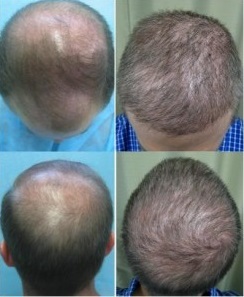
Norwood 6 patient with severe baldness reverses his hair loss condition through a body hair transplant surgery*
Hair Transplant Repair
Every hair transplant patient hopes to achieve the coverage and aesthetics that they visualized following their first procedure. But in reality, this does not always occur. Sometimes the wrong grafts were selected. Or the extracted hair follicles were mishandled, leading to a lowered or non-existent hair yield. Inexperienced surgeons may do a poor job of inserting grafts, creating unnatural looking angles and awkward results.
These types of mistakes make hair transplant repair surgeries a necessity. There are different types of procedures. Common reasons for needing hair repair include:
(1) scars, slot formation, pluggy grafts and failed growth from outdated procedures such as:
- scalp reductions
- temporoparietal-occipital flap surgery
- punch grafting
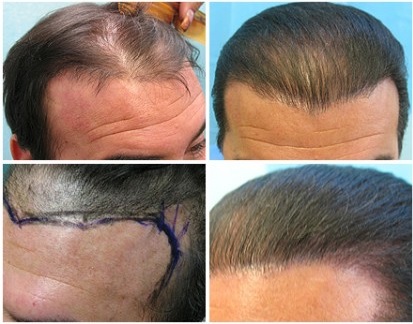
Through the strategic use of FUE, this patient was able to finally achieve a natural looking hairline after his Juri flap surgery*
(2) poorly inserted grafts creating hair that points in the wrong direction or other issues like asymmetrical hairlines
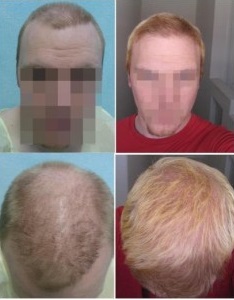
Patient was able to correct his asymmetric hairline from previous surgery using grafts taken from body regions.*
(3) lack of expected hair growth yield
(4) strip scars from FUT that the patient wants to camouflage so that they can wear their hair shorter.
With each surgery following the first operation, the number of head donor grafts becomes depleted. Repair patients therefore face the dilemma of needing a significantly large number of grafts which often exceeds the quantity they actually have.
UGraft gives surgeons an effective and reliable tool to remove large supplies of body hair that would otherwise face the risk of being easily damaged. And with this capability, new hope is made available to hair transplant cases that were considered impossible to fix due to exhausted donor supplies.
Hair Loss Procedures For Men
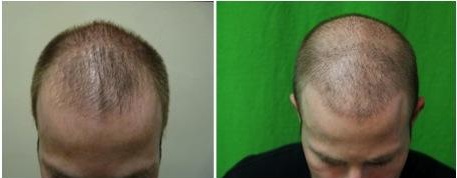
Despite a conservative donor graft count, this patient was able to achieve a soft hairline due to the strategy of inserting grafts through a diffuse density array.*
With this methodology, Dr. Umar he has been able to produce a solid track record of excellence on numerous patients. Some of these individuals have sought help for mild to moderate forms of hair loss. Others have presented more challenging cases such as:
(1) Severe baldness
(2) Poor donor depleted outcomes due to past hair transplant surgeries
Dr. Umar has been able to offer new possibilities through successful restoration for these types of patients.
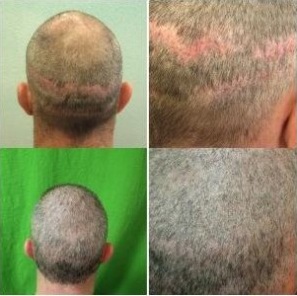
Through the additional donor grafts provided by the beard area, this patient was able to achieve the coverage he wanted with beard hair grafts*
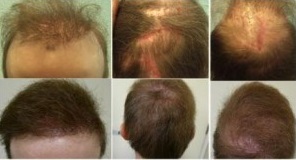
Due to multiple past surgeries and the severity of scarring, this patient’s case was nearly hopeless had it not been for his body head to hair transplantation.*
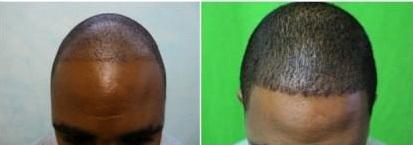
Dr. U specializes in customizing FUE procedures to suit the needs of ethnic patients, such as individuals of African descent.*
Hair Restoration in Women
Dr. Umar has been able to apply his Advanced FUE methods with uGraft for eyebrow hair transplant procedures. Many women are not able to grow the full, well defined brows that they want.
Although eyebrow hair transplant procedures have been available for years, they use follicles from the head, where hair is quite thick.
Dr. Umar is able to create more natural looking results by using hair from the nape, arms or legs.
He also offers the following procedures for women
- hair restoration for female pattern baldness (in women who qualify as candidates)
- hair transplant procedures for Traction Alopecia
Eyebrow Transplant Surgery
There are many individuals who long for improved fullness and density in their eyebrows. Lush, well defined brows is an aesthetic standard that is often set forth by celebrities and models. It is a rather common tendency for people with sparse eyebrows to compare themselves negatively and thus seek solutions to improve their appearance in this regard.
Brow hair deficiency is usually caused by genetics. Beauty experts in magazines will often make the recommendation of simply growing out the brows and redefining their shape. But this is not possible for those who have limited eyebrow hairs due to their DNA.
Another common reason for having diminished brow hair includes overplucking or overwaxing and the like. Trends in eyebrow aesthetics change over the decades. In the past (eg. 1990s and 1920s), it was quite fashionable to have pencil thin eyebrows. Therefore, women would aim for the look skinny arches and rely on hair removal techniques quite liberally.
With the recent popularity of full eyebrows, as demonstrated by the likes of Kim Kardashian and Brooke Shields, many people regret their decision to remove much of their brow hair. In time, the hair follicles in this region stop producing new shafts, Hair loss due to removal methods therefore becomes permanent.
In addition to genetics and excessive plucking , hormonal changes due to age can also render irreversible hair loss as the follicles become incapable of growing new strands.
Transplant Surgery – For Eyebrow Hair Loss and Sparsity
Through surgical means, there is hope for those who long for fuller brow hair as well as improved shape and definition
The modern techniques of hair transplant surgery used to treat male pattern baldness can also be applied to the eyebrows. Therefore, patients are able to choose the same methods that are used on the scalp. These include:
- strip surgery (also known as Follicular Unit Transfer or FUT)
- Follicular Unit Extraction (FUE)
In strip surgery, a narrow sliver of scalp tissue is removed from the scalp to provide hair grafts. This creates a linear scar. And in FUE, punches are used to remove individual groupings of hair. The wounds and any subsequent scarring are therefore in the form of tiny dots.
UGraft and Advanced FUE For Highly Natural Looking Eyebrow Transplant Results
The Office of Dr. U recognizes how much patients value undetectable and natural looking results. Therefore our use of Advanced Follicular Unit Extraction technology and methods prioritize the following two factors to achieve true-to-life outcomes without obvious signs of surgery:
- use of hair grafts that closely match real eyebrow hair
- visibly negligible scarring from wound healing results
JAAD (Journal of the American Academy of Dermatology), a well reputed medical journal, has published a study on Dr. Umar’s work using leg hair grafts. Leg hairs have a shorter maximum length and a desirable, thin caliber Thus they are a very ideal choice for creating soft, subtle definition along the edges of the final brow results.
By contrast, more conventional forms of eyebrow transplant surgery have maintained the use of regular head hair which is much thicker than what is found in the brow region. Therefore, results can be quite harsh in appearance and undermine the aesthetics of the patient’s face.
If thinner leg hair is not available, then nape hair is another option that would also be able to render the soft and subtle quality that is often desired in eyebrows. An observational study by Dr. Umar featuring the results of real patients who had nape hair inserted as grafts was released by another leading medical journal, known as Derm Surgery.
Both leg hair and nape hair have been shown to last long term and provide patients with extremely gratifying results.
Using UGraft For the Eyebrows
Although it would seem obvious to choose thinner hairs in reconstructing the eyebrows, this objective has long been a challenge to execute in real life. The primary reason has been due to the limitations of standard extraction tools.
Due to permanent linear scarring, strip surgery is not recommended for removing hair in the legs or the very outer edges of the nape where the finer, thinner hairs grow.
Typical Follicular Unit Extraction punches use a basic cylindrical design. Although this is sufficient for the majority of head hair which grows straight and close to a ninety degree angle, this structure is likely to damage leg and nape hair. The trajectory of these grafts tends to be angled.
Since UGraft is designed to safely remove a diverse range of different follicle types, it is the optimal instrument to use when extracting thinner hairs for eyebrow transplant surgery.
This patient no longer wanted to rely on brow tattoos. Instead she wanted to restore natural looking hair growth. Nape hair grafts were extracted and inserted to fulfill her vision. Here are before and after photos of her results.
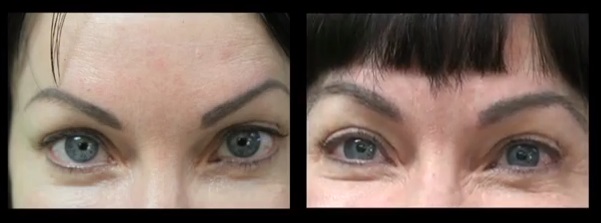
UGraft was used to remove thinner nape hair to create softly defined brows and cover unwanted tattooed arches.*
Here is a video where her eyebrow restoration procedure was discussed by Dr. Bruce Hensel on KNBC News, Los Angeles.
Here is another female patient who underwent an eyebrow reconstruction surgery using nape hair. She admired the prominence of Kim Kardashian’s brows and wanted to apply similar elements for her results:
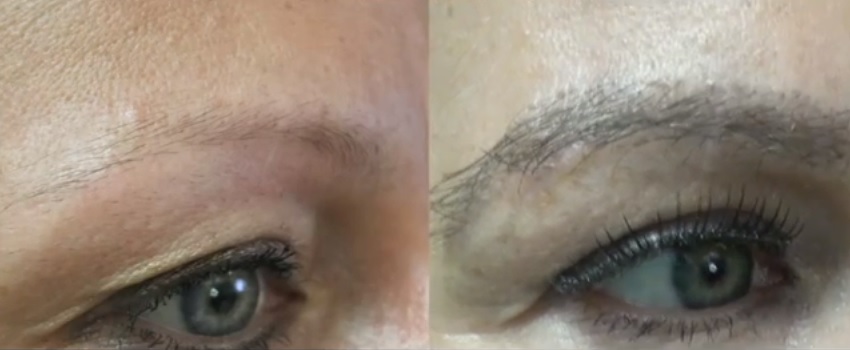
These eyebrow results were achieved with nape hair. Not only did this patient desire improved density, but also wanted to make slight improvements in the shape of her natural brows.*
Watch this video to hear the patient’s comments and feedback and see the overall effect of the new brows for her facial appearance.
This male patient longed for better definition in his eyebrows. He felt that his natural brows were too sparse and looked almost non-existent from afar, creating an awkward overall appearance. Because he wanted a very subtle looking improvement, Dr. Umar used fine leg hair grafts to achieve this aim.
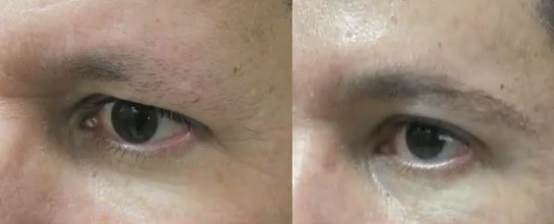
Leg hair was able to elongate the patient’s eyebrows while rendering a very soft and natural looking definition. The patient was very happy that other people could not tell he had a procedure done.*
This patient discusses he reasons for undergoing an eyebrow transplant procedure as well as his feedback on his final results. Here is his video:
Eyelash Transplantation
The Office of Dr. U also specializes in the application of cutting edge Advanced Follicular Unit Extraction surgical tools and techniques for creating long and extremely natural looking eyelashes. Just as with the brows, patients who opt for this procedure have genetics which limits desired hair growth. In other words, some people inherit the DNA for having long, beautiful eyelashes, there are others who are born with the capacity to grow shorter lash hairs. In other cases, eyelashes can be damaged due to the overuse of false lash strips or professionally applied extension.
However whether mechanically induced or genetic, optimal lash lengths and densities can be surgically created. For many individuals, this offers immense freedom from the ongoing time and expense needed for prescriptions, and externally applied eyelash fibers.
Through his developments in Advanced FUE, Dr. Umar is able to harvest realistic donor grafts that closely match the thickness of natural eyebrow hairs. These follicles can be harvested from the legs or the nape.
An observational study on the use of these leg hair was published by the Journal of Plastic and Reconstructive Surgery. This manuscript showed the long term viability of leg hair when inserted into the lash line. Furthermore, since leg hair grows slower and reaches a much shorter length than nape hair, less frequent trimming is required.
For a long time eyelash transplant surgery has been performed on a very restricted basis for dire cases resulting from disease or accidents. Due to advancements in methodologies and techniques, it now becoming more available to patients who simply want their own set of long eyelash hairs.
In addition to Dr. Umar’s specialized technology and techniques to acquire the best and most natural looking graft matches for eyelash hair, he is also able to insert the grafts to mimic the upward curvature of lashes. This requires the use of curved shaped insertion needles. Without such measures, the lash grafts are likely to grow straight and downward. This requires patients to rely on manual curling implements or regular visits to eyelash perming salons. Furthermore, without a natural curl, the downward growth of eyelashes may affect the surface of the eye, causing a medical condition known as trichosis.
In summary, ideal eyelash transplant surgery results are characterized by the following:
(1) Optimal choice of hair grafts to mimic the thickness of real eyelash hairs. This would require the specialized extraction of nape and head hair, accounting for the sharp growth angles in order to safely remove such follicles.
(2) High wound healing standards. The donor regions of the leg and nape are comparably more visible than the scalp. While scar tissue is an inevitable part of any extraction procedure, it can be made cosmetically negligible and unnoticeable to the naked eye. Dr. Umar’s UGraft device creates specifically configured wound cavities to promote less extraneous tissue on the skin’s surface and thus very minimal cosmetic scarring compared to conventional extraction methods.
(3) Eyelash results which naturally curve upward and away from the eyes. This saves patients from the time and cost of constantly having to create the lash curvature themselves.
Here is an example of a patient who had nape hair grafts used for longer eyelashes.
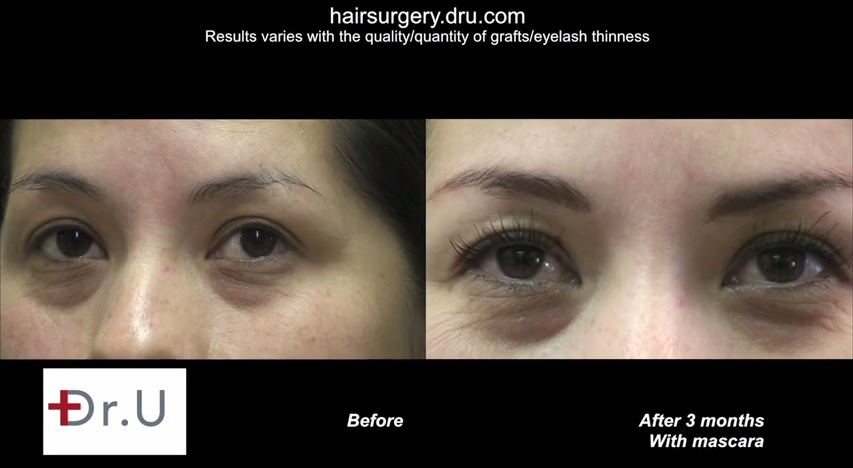
This patient was able to achieve the length and fullness that she wanted through an eyelash transplant surgery using nape hair. Here are before and after images showing her results*
In the following video, she shares her experience and how she feels about finally having the ability to grow the eyelash length that she has always wanted.
Because the right leg hair caliber was available in this patient, these grafts were used for her eyelashes. These before and after images show the difference that longer lashes made in highlighting her eyes.
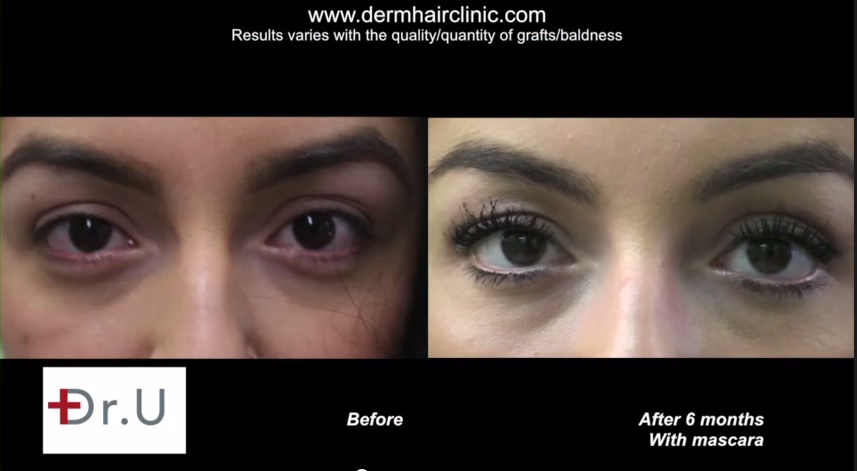
The characteristics of leg hair are ideal for use as grafts in eyebrow transplant surgery. This is mainly due to their thinness and maximum length.*
The leg hairs were able to last long term. And the patient is delighted with her new lashes as well the freedom that permanent natural growth entails. In this video, she shares her comments and even encourages other women interested in longer eyelashes to choose this form of treatment.
At the Office of Dr. U, we not only provide eyelash transplantation as a procedure, but also possess the necessary instrumentation, practices and expertise needed to create the best and most natural outcomes possible for our patients.
PATIENT PHOTOS
This patient was severely bald at a Norwood 7 rating. Individuals like this are normally rejected as hair transplant candidates. But Dr. Umar was able to create a donor pool of 12,000 grafts (performed in two separate sessions) by extracting hair from the beard region and head to provide the desired level of fullness. He also constructed a hairline similar to the one the patient used to have.
This patient relied on a hairpiece for 14 years after his strip surgery. This procedure left him with awkward looking plugs and poor coverage on the scalp. Dr. Umar was able to restore normalcy with fuller coverage and an overall natural looking outcome. This was achieved with 14,000 grafts that were transplanted in two separate sessions.
Dr. Umar was featured on Good Morning America for his work in eyebrow hair transplant procedures. His patient was inspired by the look of Brooke Shield’s brows. Dr. Umar was able to make her vision a reality using uGraft and his Advanced Follicular Unit Extraction methods.
PATIENT VIDEOS
Body Hair Transplant
In general FUE procedures, hair follicles are extracted directly from the scalp to avoid a linear scar. In the head region, this is limited to about 7,000 grafts. But this may not be sufficient for severe forms of baldness or repair surgeries.
Many patients require an expanded supply of donor follicles. This is where Advanced Follicular Unit Extraction comes in.
Advanced FUE uses the highly specialized uGraft set of tools and protocols to safely extract body hair follicles from regions such as:
(1) Beard area
(2) Nape
(3) Legs
(4) Arms
(5) Abdomen
(6) Stomach
(7) Back
(8) Chest
These areas of the skin are quite visible, unlike the hair covered scalp. Therefore the absence of noticeable scarring is a high priority for patients.
With the advanced tools and techniques of Advanced Follicular Unit Extraction, patients can experience:
(1) fullness in coverage
(2) natural looking details
(3) negligible to no scarring in body donor areas
uGraft
UGraft is a specialized surgical system that has been designed to meet the objectives of Advanced Follicular Unit Extraction. It includes both tools and protocols.
Features of uGraft Tools
UGraft instruments are both hand held, motorized. One aspect that makes them different from standard FUE tools is that they use punch units that are custom crafted using computerized software. With this level of precision, these pieces account for :
(1) exceptionally small wound sizes in the donor areas
(2) shape of the excisions to optimize the healing process
Another special feature offered by uGraft is the subtle graft pulling mechanism. This helps ensure the safety and survival of the extracted follicles. Also this feature addresses the non linear growth patterns of hair.
Angled or curved growth can make it difficult to identify the best placement of an FUE punch. Follicles can be damaged or buried by inaccurate positioning of surgical instruments.
Medical Treatments
Conventional medical treatments for addressing androgenic alopecia include two FDA drugs that have been approved for this purpose. These include:
- Minoxidil (Rogaine)
- Finasteride (Propecia)
Minoxidil and Finasteride must be used consistently to maintain desired effects. However, there is no guarantee how well these medications will work for individual patients. Additionally, like all drugs, they are associated with the possibility of dangerous side effects. Individuals who wish to consider the use of medications for restoring hair will need to weigh the benefits against the potential risks before committing to a decision.
Minoxidil For Reversing Hair Loss
Minoxidil is available over the counter. Men typically use the 4% concentration. The 2% formulation can be used by women or males.
This drug is believed to work by increasing blood flow to the scalp to help strengthen hair follicles that have started to miniaturize. It is also likely that it promotes certain prostaglandins which stimulated the growth of new hair.
Possible Side Effects
- weight gain
- heart rate changes
- swelling of face & extremities
- headache
- dandruff
- itching
Finasteride As A Hair Loss Treatment
Finasteride can only be obtained on a prescription basis only. This drug lowers the concentration of DHT in the blood stream. It achieves this by blocking the enzyme (alpha-II-reductase) which causes testosterone to break down into dehydrotestosterone.
Finasteride can only be used by men. It may result in birth defects when taken by women.
This drug is known by various brand names such as:
- Propecia
- Proscar
Side Effects
A brief list of side effects associated with Finasteride include:
- sexual dysfunction
- chills
- confusion
- dizziness
Natural Supplements for Addressing Hair Loss
With the dangers of possible side effects from using pharmaceutical drugs for treating hair loss, would it be unrealistic to search for new answers within the realm of natural plant derived ingredients?
There are an increasing number of carefully designed research studies being done on the effects of natural compounds for a myriad of health conditions, including hair loss. And for this reason more people are seeking safer alternatives from plant extracts.
Unlike synthetic chemicals, plant derived compounds are accompanied by sub-units found in the original organism which help balance out any excessive effects from the main active ingredient. This is a major reason why the risk of side effects from natural sources are far less compared to pharmaceutical drugs.
More doctors, including Dr. U encourage patients to consider the risks against the possible benefits when considering natural or synthetic medical treatments.
Complimentary Consultations For Hair Loss
Dr. Umar offers initial consultations on a complimentary basis for those who are interested in restoration for hair loss. To get started with scheduling an appointment, please fill out our online consultation form.
We can also be reached at 877-337-6424

Patients seeking a hair transplant surgery will need to consider both coverage and proper facial aesthetics.*

